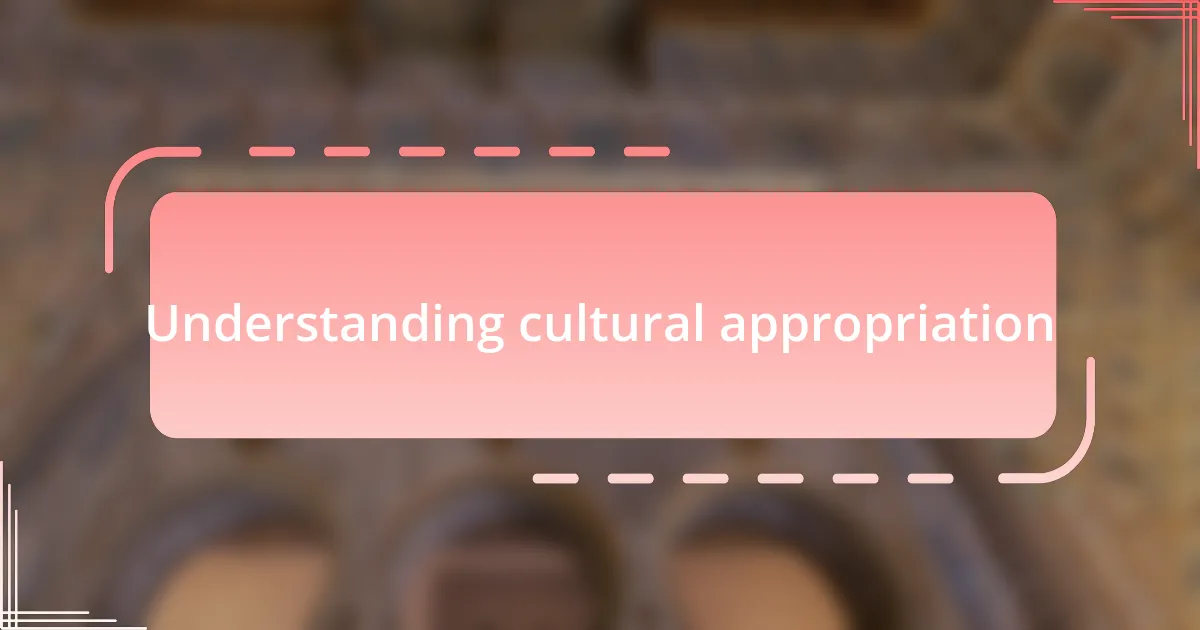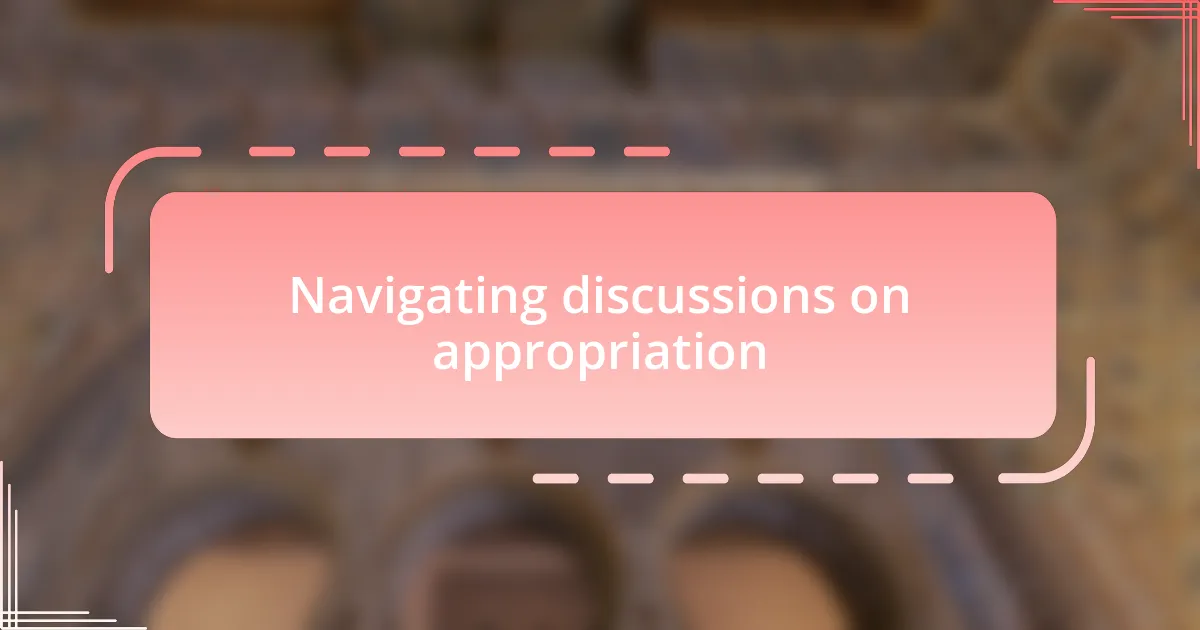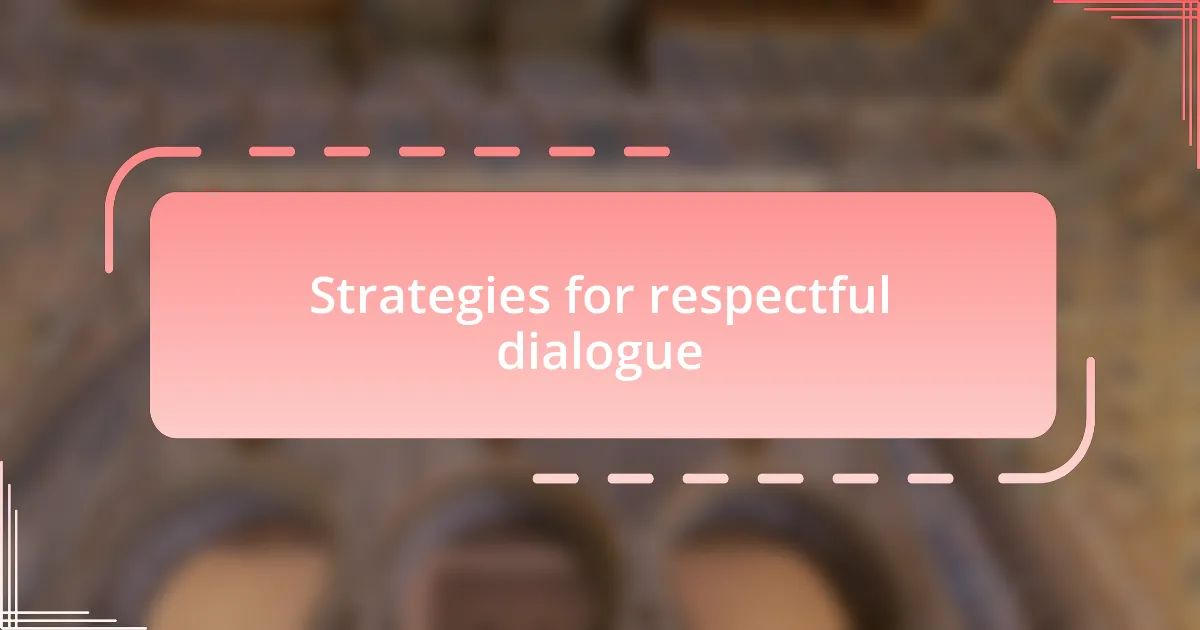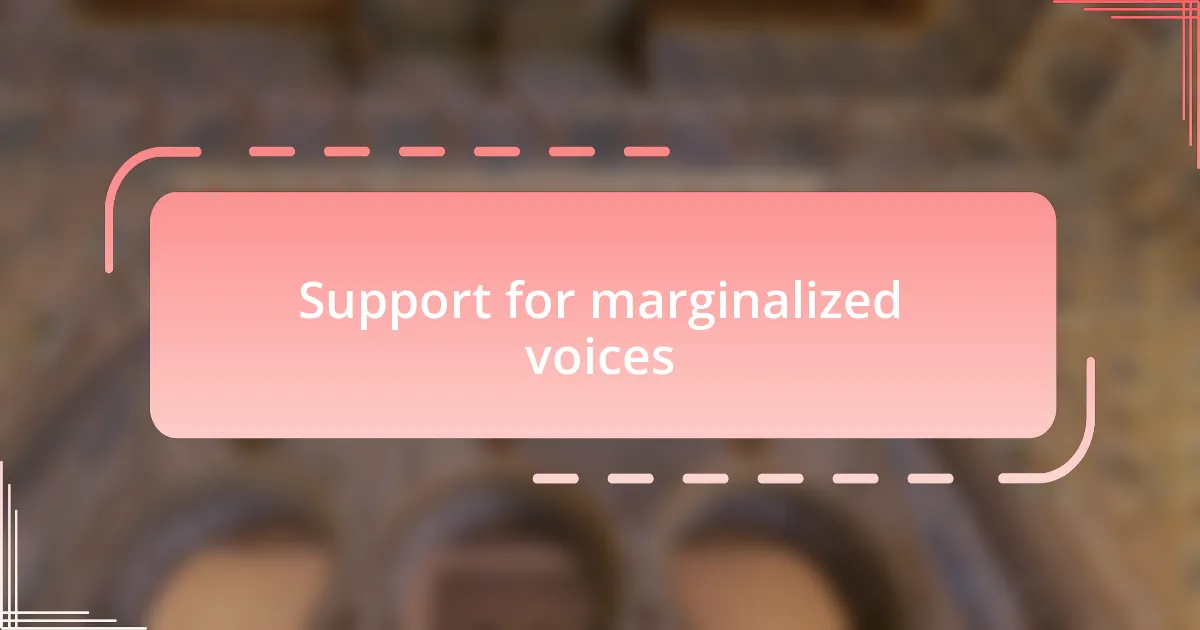Key takeaways:
- Cultural appropriation involves using elements from one culture by members of a more dominant culture, raising issues of respect and representation.
- Audio-visual heritage plays a crucial role in preserving cultural languages and narratives, fostering empathy, and understanding diverse perspectives.
- Engaging in dialogues about appropriation requires active listening, validating emotions, and creating safe spaces for respectful discussion.
- Supporting marginalized voices is essential for recognizing their lived experiences and promoting diverse cultural expressions in conversations about heritage.

Understanding cultural appropriation
Cultural appropriation is a complex and often contentious issue that arises when elements of one culture are taken and used by another, especially by those in a position of power. I remember attending a vibrant art festival where the misuse of indigenous patterns sparked heated discussions among attendees. How can we celebrate a culture without misrepresenting or commodifying it?
This concept extends beyond mere appreciation; it involves tangible aspects such as history, identity, and power dynamics. One time, I found myself at a café where a traditional dish from my heritage was served with a twist that felt disingenuous. It was jarring to witness my culture’s food being reduced to a trendy novelty rather than being respected for its rich origins. Have you ever felt a similar disconnection with how your culture is represented?
By exploring these narratives, we can begin to understand the emotional weight that comes with cultural symbols. When I see clothing adorned with sacred icons being worn as fashion statements, it evokes a sense of loss and frustration. This connection makes me wonder—what responsibility do we have to honor the origins of these symbols, especially in creative spaces like art and fashion?

Importance of audio-visual heritage
Audio-visual heritage is invaluable as it serves as a bridge connecting past and present, helping us understand cultural narratives. When I watch a documentary that features historical footage, I often find myself transported to another time, feeling the struggles and triumphs of those before me. How often do we stop to think about the emotional stories that these visuals tell?
Moreover, audio-visual materials can play a significant role in preserving languages and customs that may be fading away. I once stumbled upon an old recording of folk songs from my ancestors, and it struck me how vital these recordings are for future generations. It’s a reminder that each piece of audio-visual content holds a piece of our collective identity, begging the question: how can we protect these treasures for the sake of cultural continuity?
Understanding the importance of audio-visual heritage also fosters greater appreciation for diversity in our global society. I remember revisiting a film that showcased the richness of a culture vastly different from my own; it opened my eyes to perspectives I had never considered. In this way, audio-visual heritage not only enriches our personal experiences but also nurtures empathy among different cultural groups.

Navigating discussions on appropriation
Engaging in discussions about cultural appropriation can feel daunting, especially when emotions run high. I remember a time when I attended a workshop that tackled this very issue. The atmosphere was charged, and as we shared our views, I realized how crucial it is to create a space where everyone feels heard, even if we don’t agree. How can we ensure that varying perspectives contribute to a deeper understanding rather than division?
When navigating these discussions, context is king. I often find myself reflecting on the stories behind specific cultural elements. For instance, after learning about the significance of traditional attire in a community, I became more mindful of how it’s represented in media. It raises an important question: How do we balance appreciation with respect for the origins of these cultural expressions?
As we delve into these conversations, I’ve learned to approach them with curiosity rather than defensiveness. Admittedly, there are moments when I feel unsure about my role in these dialogues. However, embracing vulnerability can lead to richer exchanges. Sharing personal stories, like how a piece of art from another culture inspired me while I was creating my own work, can open the door to meaningful interactions. After all, isn’t it our shared experiences that truly bring us together?

Personal experiences with appropriation
One of my first encounters with appropriation discussions was during a college project on traditional music forms. As I dived into the research, I couldn’t help but reflect on a time when I casually incorporated elements of Indigenous music into my own compositions. The realization hit me hard: Was I truly celebrating their culture, or was I inadvertently stripping it of its significance? This moment sparked a deeper understanding of how easily one can cross the line from appreciation to appropriation.
Recently, I volunteered at a cultural festival and witnessed firsthand the mixed reactions to a popular band performing songs from various cultures. While many celebrated the fusion, a few attendees expressed frustration, noting that those original artists often went unrecognized. It made me consider: Who benefits from these creative exchanges? In that moment, I felt the weight of responsibility as I recognized my own tendencies to overlook the nuances of artistic borrowing.
Navigating these experiences can be emotionally complex. I recall feeling defensive when a friend pointed out my naive views about artistic freedom concerning cultural symbols. It stung, but that discomfort pushed me to engage more profoundly with the topic. It made me ask, how can my interactions with diverse cultures evolve in a way that honors their heritage and fosters genuine connection? Each moment like this serves as a lesson in humility and growth for me.

Strategies for respectful dialogue
Engaging in discussions about cultural appropriation requires a commitment to active listening. I remember a particular workshop where participants were encouraged to share their experiences without interruption. At first, it felt uncomfortable to resist the urge to respond immediately. However, this practice allowed me to truly absorb different perspectives and paved the way for more meaningful conversations. How often do we rush to express our thoughts instead of pausing to understand the feelings of others?
Another strategy I’ve found effective is validating the emotions of others during these dialogues. Once, during a panel discussion, an artist expressed anguish over their work being misrepresented. Instead of jumping in with my own opinions, I acknowledged their pain and asked follow-up questions. This not only fostered trust but also deepened my understanding of the impact of appropriation. In moments like these, I remind myself that empathy can bridge divides and encourage openness.
Finally, creating a safe space for dialogue is crucial. I once hosted a community gathering aimed at exploring cultural expressions in the arts. By setting ground rules that emphasized respect and understanding, participants felt more at ease sharing their thoughts. It became clear to me that establishing a supportive environment can transform potentially charged discussions into enriching exchanges. How can we ensure that our dialogues remain respectful and productive in the face of differing opinions? This is an ongoing journey for me as I continue to learn and evolve in my understanding of cultural dynamics.

Support for marginalized voices
Support for marginalized voices should be an integral part of any discussion on cultural appropriation. I vividly recall attending a film screening that focused on the narratives of indigenous communities. The filmmakers shared their intimate stories, and for me, it was a profound moment when their voices were prioritized over mainstream interpretations. It struck me that supporting marginalized voices is not just about inclusion; it’s about recognition and respect for their lived experiences.
In my interactions with artists from underrepresented backgrounds, I’ve witnessed the transformative power of amplifying their voices. During a recent event, I facilitated a roundtable discussion that gave a platform to local artists to showcase their art and share their stories. Seeing the relief in their expressions as they spoke their truths reminded me of the urgent need for spaces where their contributions are valued. How often do we think about the barriers these artists face in a world saturated with dominant narratives?
Moreover, actively promoting work by marginalized creators can shift the cultural landscape. When I discovered a podcast featuring indigenous perspectives, I was captivated not just by the content but by the urgency of their insights. Sharing such resources with my circles has become a priority for me, as it’s essential to widen the lens through which we view culture. I often wonder: what if we committed to uplifting these voices in every conversation we have about cultural heritage? The ripple effects could be profound.